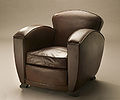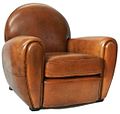Club chair
A club armchair is a durable luxury armchair in the style of Art Déco . It is a fully upholstered armchair that was originally used to furnish club and lounges, especially in the English gentlemen's clubs of the 1930s; this is how the name came about.
origin
Club chairs were mostly covered with leather and had a loose seat cushion. From a technical point of view, the hallmark of a club chair is always a classic upholstery structure, as was common in the time it was created, using classic upholstery material. Construction, processing and the materials of the 1930s guaranteed not only the characteristic shape but also the corresponding seating quality, which is not easy to achieve today with industrial upholstery technology.
construction
The basis of a club chair is always a stable wooden frame, ideally made of hardwood such as beech and oak, but in some cases also made of softwood such as spruce or fir. The frame was stretched crosswise on the underside with jute straps and thus received a solid basis for the subsequent upholstery structure. So-called “double cone springs” or “waist springs” were used to achieve the desired upholstery height and high seating comfort. They were used as individual springs to build up conventionally laced feather pads. These springs were invented as early as 1790, but were initially still used as open, untied springs. They only became usable with the knowledge of steel wire production in the 19th century; they then had their heyday in Biedermeier and historicism .
The waist feathers were sewn onto the straps in the correct position with at least four stitches. Here it was particularly important to work with foresight: A spring now with the knot in the top spring ring at an angle of 45 ° to the cross of the belt set a later “French lacing of the filler threads”, a knot at an angle of only 22.5 ° later a “German Lacing ”ahead. Depending on the choice of stitch, you could loop around the spring ring half or completely, but the sewing stitches had to be pulled close to the spring ring to prevent the springs from shifting.
Sewn on the jute belts like this, the feathers could be brought into shape according to the desired degree of hardness and the desired height with individually set “adjusting, return and knot threads” in lengthwise and crosswise lacing with loops, beans and knots. For such seat upholstery, six to eight-course waist springs with an unloaded spring height between 17 and 34 cm and wire diameters of 3.2 to 4.0 mm were generally used. The larger the wire diameter selected, the greater the load-bearing capacity of the cushion.
To achieve the seat incline and greater flexibility, the springs decreased in number and wire diameter towards the rear. Club chairs with a built-in seat edge were given a raised front edge by attaching the springs in the front row to the front frame or a wooden strip attached there with staples. A jute strip previously attached underneath prevented annoying noises during use (and is still known today as "rattle strips"). Raising the front row of springs required springs with a lower number of turns and meant that these springs had to be tied separately as a so-called "free-standing spring edge". The outer spring washers were then reinforced with edge wire. The conclusion was formed by filling threads, in which one basically differentiates between the double right-angled lacing (double French lacing) and the diagonal lacing (German lacing). The difference between the two laces is that the German lacing creates a firmer surface, as the top spring ring is grasped eight times, compared to the French lacing, in which the spring ring is only grasped four times.
The upholstery structure that was created was covered with a layer of feather canvas. The following molded padding (older term "Fasson"; French: form) is the supporting padding layer with little softness, which is shaped by the padding edge. The most common upholstery fillers for this were vegetable fillers such as Afrik , which is obtained from the leaves of the dwarf palm ; but also alpine grass or forest hair, so-called sedge , were common in southern Germany. Glazing stitches were drawn on the feather linen, about three centimeters of filler was placed on top and plucked well and pushed under the glazing stitches. Then the canvas was stapled over, pinned on and sewn through, sat through and pulled again. The following pricking out of animal fillers such as cowhair and horsehair compensated for the unevenness of the molded cushion and gave the cushion the necessary surface softness.
The seat of a club chair was rounded off with a loose, feather-filled cushion. The classic upholstery structure described should definitely be located in the seat and back area of such an armchair, but it also occurs in the armrests of some armchair shapes.
reference
Most of the armchairs were covered with leather . A cover with fabric such as flat weave or velor was rather rare for this type of armchair at the time of its creation and was only preferred in the 1950s and 1960s. The leather was vegetable tanned. Vegetable tanning agents are among the oldest substances that humans have used for tanning; the tannin contents vary between 8 and 70 percent. The fact that the leather is often patinated , i.e. colored by hand after the armchair has been upholstered (cuir patiné), also makes these pieces visually unique.
Examples
The club armchair was usually built in the period between the two world wars, i.e. in the years 1920 to 1940; Many forms of club armchairs produced at that time can be seen as typical "Art Déco". Famous designers included Ray and Charles Eames from the USA.







